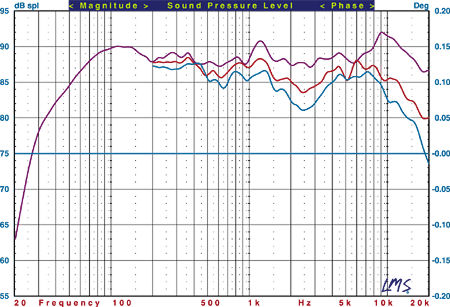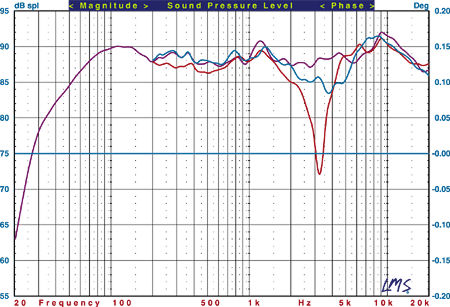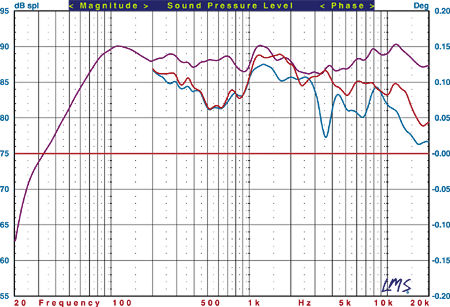B&W DM 602 Series 3 Surround Speaker System Measurements
The B&W DM 602 S3's bass alignment is tuned to approximately 38Hz (the minimum impedance magnitude in the "saddle" between the two main impedance peaks typical of a ported enclosure), with a minimum impedance of 2.91ohms at 12.5kHz. This high-frequency minimum will not unduly stress an amplifier, particularly since the phase angle of the impedance at this frequency is a benign –10°. The next lowest value is 4.73ohms at 172Hz. The 602 should be an easy load to drive for any competent amplifier. The speaker's sensitivity measured approximately 87dB/W/m across most of the midrange and treble—somewhat lower than specified, but an average value for a contemporary speaker.
All frequency-response measurements were made with no plugs in the ports. The horizontal front response of the DM 602 S3 is shown in Fig.1 (violet), the pseudo-anechoic response averaged over a 30° forward horizontal angle, at tweeter height, and combined with the nearfield responses of the woofer and port. The 602's effective lower limit (–10dB at 33Hz) is very good for a speaker of this size, though it begins rolling off gradually just below 100Hz.

Fig.1: B&W DM 602 S3, pseudo-anechoic response off horizontal axis at 45° (red) and 60° (blue)
The overall 30° front horizontal response of the 602 is smooth from about 200Hz to 7kHz. The main aberration is an obvious rise centered at 9kHz. This peak is nearly the same on-axis and 15° off-axis, but it smooths out dramatically at 30° off-axis and is consistent with the high-frequency response I heard in the listening tests. The high frequencies roll off smoothly at extreme off-axis angles, though a dip starts to appear at around 2–3kHz, reflecting the decreased dispersion of the woofer, which is still active at those frequencies.
All measurements presented here were made with the grilles removed. The response of the 602 was also measured on-axis with the grilles in place, in which case it was noticeably more erratic through the upper midrange and low treble, but with no significant effect on the 9kHz peak.
The vertical response shown in Fig.2 indicates that the DM 602 S3 should sound best when the height of the listener's ears is as close as possible to that of the tweeter. Standing up puts a pronounced dip in the presence region—something to keep in mind when auditioning these speakers.

Fig.2: B&W DM 602 S3, pseudo-anechoic response at 15° above (red) and 15° below (blue) tweeter.
The LCR 600 S3 center-channel speaker is tuned to about 33Hz. Its impedance reaches a minimum of 3.1ohms at 14.5kHz, but, as noted above, this is less significant than the 5.1ohms minimum at 33Hz. In any case, the speaker should be a relatively easy load to drive. Its sensitivity measured approximately 87dB/W/m.
The LCR 600 S3's measured front horizontal response, taken on the tweeter axis and averaged in the same manner as described above for the DM 602 S3, is shown in Fig.3a and Fig.3b. The speaker's effective lower limit (–10dB) is approximately 45Hz. Because of the 21/2-way design of the crossover, the 600's horizontal dispersion is asymmetrical; that is, different in different directions. Such a 21/2-way network may have useful characteristics, but improving the horizontal dispersion of a horizontally configured center-channel is not one of them, as we have seen in other, similar designs. While it isn't shown here, even sitting 15° off-axis on the side nearest the port results in a dip of about 5dB centered at about 4kHz. This explains the slight woofy quality noted in the sound, particularly on vocals.

Fig.3a: B&W LCR 600 S3, pseudo-anechoic response off horizontal axis at 45° (red) and 60° (blue) in direction of port.

Fig.3b: B&W LCR 600 S3, pseudo-anechoic response off horizontal axis at 45° (red) and 60° (blue) in direction away from port.
The 600 S3's vertical off-axis response is very smooth (Fig.4). In fact, it is actually a little flatter at +/-15° than it is on-axis, suggesting that the speaker might sound best when not aimed directly at the listener in the vertical plane. For example, when placing the 600 atop a big-screen TV, aim it straight ahead rather than angled down.

Fig.4: B&W LCR 600 S3, pseudo-anechoic response at 15° above (red) and 15° below (blue) tweeter.
The measurements of the DM 602 S3 and LCR 600 S3 are good for speakers in this price range. The only two results that gave me pause were the 602's peak at 9kHz and the 600's horizontal off-axis response deviations. Neither problem area was as obvious on normal program material as the measurements might suggest, though the high-frequency rise in the 602 did make the speaker more critical of brightness in the program material and/or associated components. The 600's horizontal off-axis dispersion is typical of nearly every 2- or 21/2-way center-channel we have tested in which the drivers are oriented horizontally. The best way to optimize such a speaker is with a 3-way design in which the midrange and tweeter are mounted one above the other, flanked by woofers on each side. B&W uses this approach in its more upscale models, but it isn't cheap to do well.—TJN
























































